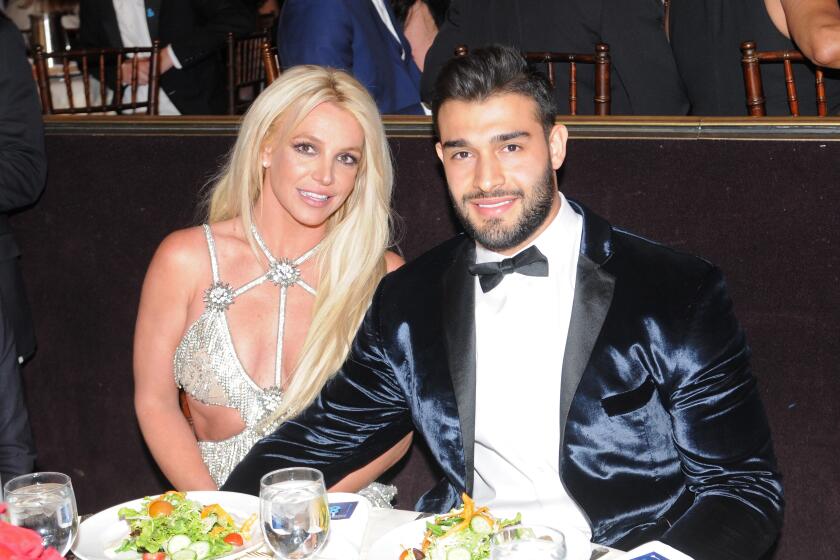Jazz Pioneer’s Funeral Sounds a Jubilant Note
New Orleans invaded Harlem and Dixieland jazz filled the streets Saturday as more than 2,000 people--including recording artists, former President Bush and passionate fans--celebrated the life of musical legend Lionel Hampton.
Led by trumpet virtuoso Wynton Marsalis, the memorial services began with a traditional New Orleans “jazz funeral” procession outside Harlem’s historic Cotton Club. A nine-member band, wailing “St. James Infirmary Blues” and other dirges, followed close behind Hampton’s white wooden hearse as it was drawn by two horses toward Manhattan’s Riverside Church.
“He represented the highest jazz musicians have to offer, the very best,” said Marsalis, who guided the crowd like a swinging Pied Piper on a warm, sunny morning. “It is an honor for me to be here and salute someone who gave us so much.”
Hampton, 94, died Aug. 31 after a long illness and left behind a profound imprint on jazz and political history. He was one of the first musicians to popularize the vibraphone, and his band became a training ground for some of the most famous names in jazz, including Charles Mingus, Dexter Gordon, Wes Montgomery, Joe Williams and Aretha Franklin.
A friend of presidents from Harry S. Truman to George W. Bush, he also was one of the first black jazz musicians to perform publicly with white musicians, helping to integrate what had been a segregated world in the 1930s.
America could not ignore the passing of such a giant, and friends “wanted to do something memorable” for his memorial, according to one organizer. Judging by crowd reactions, they succeeded.
The sight of Hampton’s funeral parade winding through Upper Manhattan astonished many on the streets, and heads kept popping out of apartment windows to watch the pageantry below. Parents held children up over their heads on the crowded sidewalks so they could catch a glimpse of the hearse, the band and the surging crowd.
“I think it was important for them to be here,” said David Hackle, pointing to his daughter Oni, 6, and his son Ojani, 2. “There’s so much tradition here, with the funeral parade and Hampton. I’ve never seen anything quite like this in New York City.”
By midmorning the procession reached the landmark church overlooking the Hudson River, and the music continued inside. Marsalis led David Oswald’s Gully Low Jazz Band up the center aisle and blew one final hymn before retreating to the back of the building.
“We are here to remember and celebrate a true pioneer, a jazz icon who touched all of our lives,” said the Rev. James A. Forbes Jr. “Lionel Hampton filled our hearts with joy.”
One speaker after another recalled Hampton’s trailblazing work with the vibraphone, which many considered a freakish instrument until he played it in a 1930 Louis Armstrong recording session. The gifted musician, born in Kentucky, “showed the world that this was not a minor percussion instrument. It was capable of poetry and invention,” said author Stanley Crouch.
Others recalled Hampton’s courage when he and pianist Teddy Wilson joined Benny Goodman’s band in 1936, becoming the first black jazz musicians to perform publicly with white artists in the United States. Years later, Hampton said Goodman’s quartet “opened the door for Jackie Robinson coming into major league baseball. The integration of musicians started a lot of things happening.”
Bush, his voice cracking with emotion, recalled Hampton as a close family friend. “It wasn’t easy for Lionel to be a Republican,” he said. “He not only had a knack for musicianship, he had a gift for relationships.”
But it was the music--loud, sometimes ecstatic jazz, gospel and boogie-woogie--that dominated Hampton’s two-hour memorial. Backed by the Lionel Hampton Orchestra, a parade of jazz greats including pianist Hank Jones, saxophone player Illinois Jacquet, and trumpeters Clark Terry, Jon Faddis and Roy Hargrove, swung mightily in tribute to a man with whom they had all worked.
Jacquet, speaking in a low, gravelly voice, remembered a snowy night in Chicago when Hampton’s band was warming up the crowd and the bandleader was getting dressed upstairs.
“He was excited, the band was grooving so well, that he ran onstage without his pants on,” Jacquet recalled.
The service ended with “Flying Home,” Hampton’s most famous number, and as the band reached a booming climax, mourners jumped out of their pews and began dancing in the aisles. Minutes later, the band poured back onto the streets, this time playing jubilant melodies such as “Down by the Riverside.”
“There couldn’t have been a better tribute to a man like Hampton,” marveled Kathy Hunter, a longtime fan who had driven 115 miles from Montauk, N.Y., with her husband to witness the memorial service. “There’s such joy, such energy--and we didn’t even have to go to New Orleans.”
More to Read
The biggest entertainment stories
Get our big stories about Hollywood, film, television, music, arts, culture and more right in your inbox as soon as they publish.
You may occasionally receive promotional content from the Los Angeles Times.






